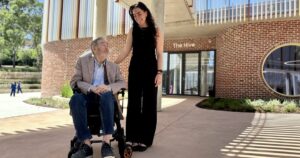
La Trobe University researchers have embarked on an ambitious space mission, sending two “cell hotels” to the edges of space to explore how microgravity affects the human gut. This groundbreaking experiment, launched on November 12 by the German Aerospace Centre (DLR) from Sweden, is part of a broader international effort to understand the impact of space conditions on human biology.
The compact “cell hotels,” each standing at just 10 centimeters, are sophisticated miniature laboratories. Developed in collaboration with Melbourne engineering firm Enable Aerospace, these cubes were among 21 experiments aboard the sounding rocket. The mission aims to provide insights into cell communication, regeneration, and potentially, cancer.
Understanding the Gastronauts Project
Professor Patrick Humbert, Director of the La Trobe Institute for Molecular Science (LIMS), leads the Gastronauts project. The initiative seeks to compare gut cells before, during, and after their journey to space, offering a unique perspective on how cells adapt to the absence of gravity. “If we remove gravity, we can discover why and how gravity is important for health,” Professor Humbert explained.
The implications of this research extend beyond astronaut health, potentially leading to medical breakthroughs on Earth. La Trobe’s Deputy Vice-Chancellor of Research and Innovation, Professor Chris Pakes, emphasized the transformative potential of these experiments, stating, “These experiments could have far-reaching consequences.”
Design and Execution of the Space Mission
The MAPHEUS-16 mission marks La Trobe’s third collaboration with the DLR. The intricate design and testing of the cell hotels took a year, involving a team of experts including La Trobe University’s PhD researcher Samantha Melrose, Dr. Amir Nasiri Kenari from the University of Tokyo, and Enable Aerospace engineer Geoffrey Cooper. The enclosures were meticulously crafted to maintain the viability of biological samples amid the extreme conditions of space travel.
Each module housed a “cell hotel” and a “microgravity microscope.” The cell hotel contained slides with living gut cells, capturing samples at different flight stages for biochemical analysis. Meanwhile, the microgravity microscope, featuring innovative smart slides from La Trobe’s Abbey Laboratory, documented cellular behavior changes invisible on standard glass.
Insights from the Zero Gravity Experience
During the mission, the cells experienced over six minutes of zero gravity, offering a rare glimpse into human gut biology in space. The experiments were benchmarked against identical tests conducted on Earth, allowing for a comprehensive comparison.
The MAPHEUS-16 mission launched from Esrange, operated by the Swedish Space Corporation, reaching an altitude of nearly 270 kilometers. Don Love, Director of Enable Aerospace, expressed satisfaction with the ongoing collaboration, stating, “Every time we fly, we improve the science and the working relationships required to meet such complex challenges.”
International Collaboration and Future Prospects
Dr. Jens Hauslage, leading the Aeromedical FabLab at the DLR Institute of Aerospace Medicine and an Associate Professor at La Trobe University, highlighted the significance of this international partnership in advancing life sciences research in space. “The MAPHEUS 16 campaign is an excellent example of our long-standing international research cooperation,” he noted.
As scientists eagerly await the results, the potential applications of this research could revolutionize our understanding of human health in space and on Earth. The findings may pave the way for new treatments and preventive measures for conditions influenced by gravity, offering hope for future space travelers and terrestrial patients alike.
This mission underscores the critical role of international collaboration in pushing the boundaries of scientific discovery, with La Trobe University and its partners at the forefront of this exciting frontier.







